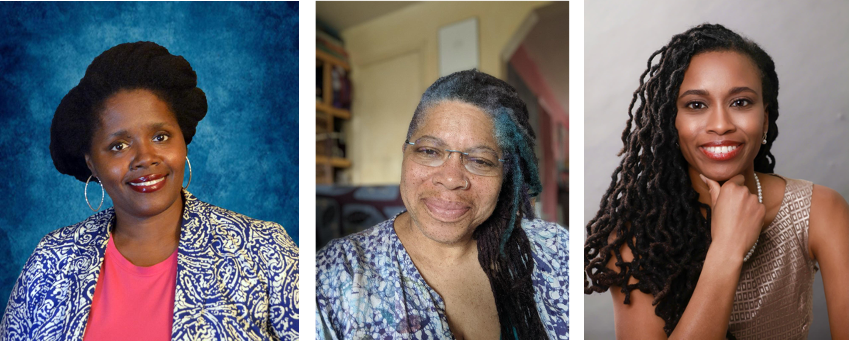This AEA365 week is sponsored by the Nonprofit and Foundations (NPF) TIG. The posts are centered around the theme of “Equity focused evaluation in small nonprofits and foundations: Innovations, learnings, and challenges.”

Hi! My name is Kimberly Harris, owner of Educa Consulting, and an independent evaluator, trained in culturally responsive and equitable evaluation (CREE) approaches. I’m Geri Peak. owner of Two Gems Consulting where I practice evaluation through the lens of spiritual demography. Hello, I am Mindelyn Anderson, Founder + Principal of Mirror Group LLC and champion for making data and information meaningful, accessible and actionable learning organizations and the communities we love. We are here to share reflections on the landscape, resources, and practices in play with equity focused evaluation with small foundations and nonprofits.
Hot Tip: Landscape
We are seeing funders striving to interact with the communities they serve more authentically. This shows up in an expansion of the roles between funder and advisor and grantee, moving from hierarchical, dominant structures of interaction to ones driven by collaborative action. The intention: to thrive in an environment that builds power collectively, free of hierarchical dominance.
Some examples we have seen include: implementing the recommendations of community members as subject matter experts in their own right and inviting program participants to have a voice in what is prioritized and ultimately funded. To varying degrees, these are all examples of moving beyond the mere acknowledgement of power differences and power imbalance to making actionable the wisdom and insights of community voices (dare we say the first stages of operationalizing nothing about us without us??).
Unfortunately, the willingness to lean into change does not automatically ameliorate the centuries of harm and collective social framing which established race-based hierarchies and infect our thinking and action today. Achieving desired outcomes around equity calls upon a multi-flanked approach, which we have begun to illustrate in the figure below.
Cool Trick: Practices
Mindset Shift requires re-examining the habits of mind that drive how we think about the work, our own role in the work, and the relationships between nonprofit and philanthropic organizations. Mindset shift requires continual reflection and adjustment that may feel foreign to entities used to finding a framework and sticking with it. As your mindset expands, new possibilities are awakened. Literally, the use of the brain is amplified.

Image credit: Equity Matters Equity Leverage Framework. Michael P. Scott with Morgan State University School of Community Health and Policy.
Authentic collaboration grows as changing mindsets open doors to new ideas, some may have already been in practice but felt inappropriate from the older way of thinking. This opens the door to co-create ways of taking action that did not exist before, at least in the relationship between funders and grantees.
Emergent practice becomes more normative, rather than rushing to a set of tools and approaches that are imposed on all relationships, the standards of operation become more relational and principled rather than defined by a set of narrow steps. These may focus on the conditions which foster more equitable contributions to practice. For foundations this may mean leaning in more rather than giving over authority. Only through collaboration can the right changes be explored.
With an “in right relationship” mindset, the regular tools of evaluation can be properly leveraged for action. For example, understanding how communities can be rendered invisible by summarizing results, allows evaluators to move beyond oversampling to engaging communities in crafting the tools and interpreting the results.
Rad Resources
Check out these collaboratives of solidarity economy leaders driving innovative practice:
Opening your mind is more important than a set of steps to follow. The resources below will help with expansion of your mind.
- Decolonizing Evaluation Week: Clarifying Decolonization Mumbo Jumbo by Geri Peak.
- NPF TIG Week: The Teaching Case: A 360 Review for Evaluators and the Partners Who Love Them! by Mindelyn Anderson.
The American Evaluation Association is hosting Nonprofits and Foundations Topical Interest Group (NPFTIG). The contributions all this week to AEA365 come from our NPFTIG members. Do you have questions, concerns, kudos, or content to extend this AEA365 contribution? Please add them in the comments section for this post on the AEA365 webpage so that we may enrich our community of practice. Would you like to submit an AEA365 Tip? Please send a note of interest to AEA365@eval.org. AEA365 is sponsored by the American Evaluation Association and provides a Tip-a-Day by and for evaluators. The views and opinions expressed on the AEA365 blog are solely those of the original authors and other contributors. These views and opinions do not necessarily represent those of the American Evaluation Association, and/or any/all contributors to this site.
